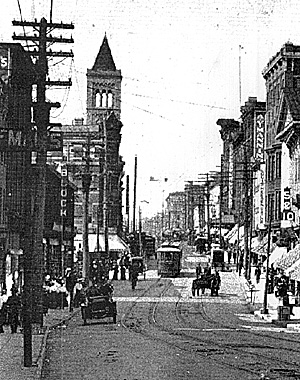
Mill Hill
Although at one point in the 1960s the epitome of urban decay, this historical section of the city has expereienced a renaissance. The homes are refurbished inside and out, and if there is one desirable address in Trenton, this is it. Mill Hill is a national historic district. In 1679, a small group of Quakers constructed a grist mill here, while in the next century, William Trent went on to lay out Trent's Town around it. In the 19th century, it was a fashionable neighborhood as Trenton's industrial base expanded. In 1840s, it was part of a larger area known as Littleworth, Kingsbury, and Kensington Hill, which was then incorporated into South Trenton. However, by the 20th, its fortunes reversed until its 1960s problems.At right, Broad Street, Trenton, from a 1905 postcard. Photo was taken with back to Mill Hill Broad Street Bridge, the site of the 2nd Battle of Trenton.
Then Mayor Arthur Holland and his wife moved into the section and began a renaissance, currently culminating in an annual historic house tour hosted by the Old Mill Hill Society.
More Trenton
This article appears in MagWeb (Magazine Web) on the Internet World Wide Web.Mill Hill Church of God
 The Second Presbyterian Church of Trenton was founded in 1842, taking delivery of a bell on May 15, 1843 from the "Lady of William R. Hansom." However, a growing congregation needed a larger church, and found a suitable site at the corner of Mercer and Market streets, which they purchased for $5500 from the Joseph Y. Launing estate.
The cornerstone was laid on June 29, 1904, with completion and dedication on March 9, 1905. On November 11, 1919, a fire burned the back half of the building. The Second Presbyterian Church eventually merged with the First, and the building was sold to the Greek Orthodox church, and again sold (1977) to the current owners, the Mill Hill Church of God.
The Second Presbyterian Church of Trenton was founded in 1842, taking delivery of a bell on May 15, 1843 from the "Lady of William R. Hansom." However, a growing congregation needed a larger church, and found a suitable site at the corner of Mercer and Market streets, which they purchased for $5500 from the Joseph Y. Launing estate.
The cornerstone was laid on June 29, 1904, with completion and dedication on March 9, 1905. On November 11, 1919, a fire burned the back half of the building. The Second Presbyterian Church eventually merged with the First, and the building was sold to the Greek Orthodox church, and again sold (1977) to the current owners, the Mill Hill Church of God.
Introduction
Old Barracks Museum
Alexander Douglass House
Trenton Battle Monument
William Trent House
NJ State House
Mill Hill Section
War Memorial, Old Masonic Lodge
Trenton Map (Large: 141K)
Back to List of Battlefields
Back to Travel Master List
Back to MagWeb Master List of Magazines
© Copyright 1998 by Coalition Web, Inc.
Other military history articles and gaming articles are available at http://www.magweb.com